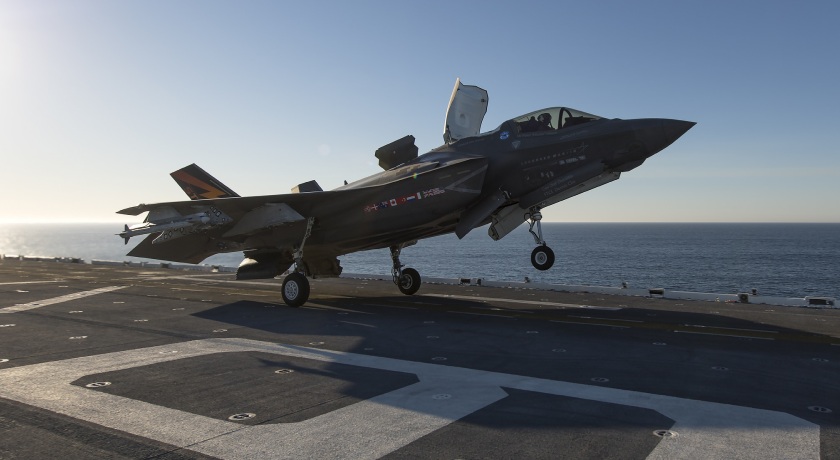The two largest operators of the Short Take-off Vertical Landing (STOVL) 'B' variant of the fifth generation F-35, the US and the UK have stepped up their operation of the next-generation combat jet, opening opportunities for future procurement around the world.
To continue reading the rest of this article, please log in.
Create free account to get unlimited news articles and more!
The F-35B STOVL variant is the world's first supersonic, stealth STOVL aircraft and is designed to operate from austere bases and a range of fixed-wing aircraft capable ships, namely large deck amphibious warfare ships, like the US Wasp and America class Landing Helicopter Docks (LHDs), UK Queen Elizabeth Class Aircraft Carriers, the Italian Cavour and Giuseppe Garibaldi Aircraft Carriers and Italian Air Force and future Turkish LHDs based on the Juan Carlos/Canberra class LHDs near frontline combat zones.
The F-35B can also take off and land conventionally from longer runways at major land based airbases. As the primary customer of the F-35B, the United States Marine Corps achieved initial operational capability (IOC) in July 2015, with aircraft delivered to both the United States and United Kingdom as production, operation and deployment rates begin to increase.
The F-35B will replace the AV-88 Harriers in operation with both the US Marines and Royal Navy and Royal Air Force. Beginning with the first permanent overseas deployment of the F-35B by the US Marines to Marine Corps Air Station MCAS Iwakuni, Japan in 2017, both the United States and United Kingdom have begun to step up the operational temp and deployment of the fifth-generation platform in response to mounting global turmoil.
In the past month, the UK officially took delivery of F-35B with the Navy's new HMS Queen Elizabeth from the US, marking the first time in eight years that a jet has landed on the deck of a British aircraft carrier. This delivery marked the beginning of trials and integration of the F-35B in conjunction with the Integrated Test Force (ITF) based at Naval Air Station Patuxent River.
Commodore Andrew Betton, Commander UK Carrier Strike Group, said, "As a critical step towards delivering the UK’s new Carrier Strike Group, this deployment demonstrates the astonishing collaborative effort that will enable the new F-35 jets to fly routinely from our Queen Elizabeth Class aircraft carriers."
Four F‑35B Lightning developmental test pilots, who are members of the ITF, will embark to fly the aircraft; three British, one American. The British personnel comprise a Royal Navy Commander, a Squadron Leader from the Royal Air Force and one civilian test pilot. They will be joined by a Major from the US Marine Corps. These trials follow the recent arrival into the UK of the first joint Royal Navy, Royal Air Force F-35B jets, based at RAF Marham. ‘Operational testing’, utilising British F-35B aircraft are scheduled to take place on board HMS Queen Elizabeth next year.
Captain Jerry Kyd, Commanding Officer of HMS Queen Elizabeth was excited about the future of the F-35B's future with the UK Armed Forces, saying, "These first F-35B embarked trials in a UK aircraft carrier are not only key to future operational success, but represent an iconic moment for the modern Royal Navy."
For the United States, the F-35B has recently begun to play a central role in response to mounting tensions in the Middle East, with the USS Essex, a Wasp class LHD, carrying F-35Bs deployed to the region, with the aircraft described as a key component of the amphibious force, providing advanced ISR (Intelligence Surveillance Reconnaissance) capabilities where needed as part of CSO (Crisis Support Operations) that involve the commitment of a quick reaction force to respond to tensions in theatre to a major conflict that requires the whole capability of the Marine Air-Ground Task Force (MAGTF).
Colonel Chandler Nelms, Commanding Officer of the US Marine Corps 13th Marine Expeditionary Unit (MEU) said, "Theatre Amphibious Combat Rehearsal (TACR) allows us to demonstrate the enhanced capabilities and tactical lethality that embarked F-35Bs on an Amphibious Ready Group (ARG) bring to the region. When combined with inherent capabilities of the 13th MEU and Essex ARG, the F-35B strengthens the amphibious force through new and increased multi-mission capabilities, making our team a more lethal and survivable crisis response force."
Both the US and UK are establishing the basis for the global operating, maintenance and training procedures for the F-35B and the future operators who will operate the next-generation, fifth generation combat aircraft, reducing the operational and procurement costs of the aircraft, raising the possibility of future procurement by countries looking to leverage the unique capabilities of the F-35B platform.

 Login
Login







